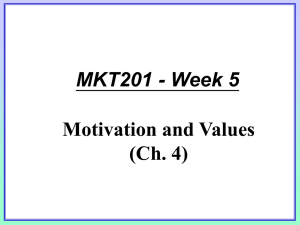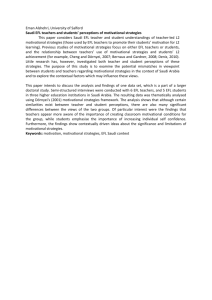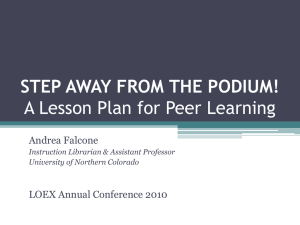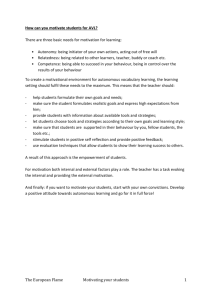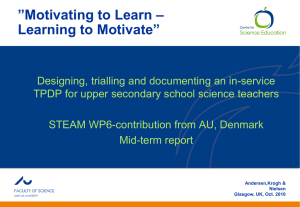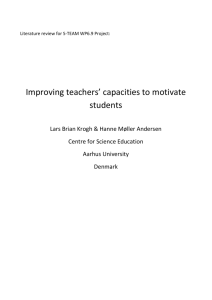data collection report, wp6.9, au
advertisement
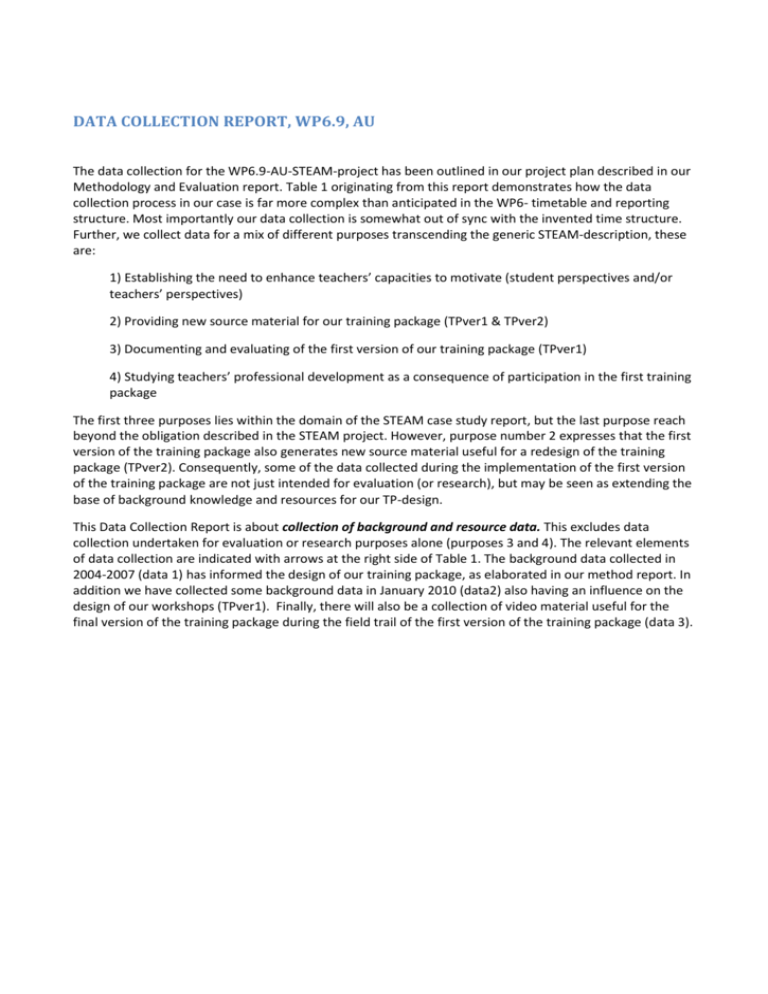
DATA COLLECTION REPORT, WP6.9, AU The data collection for the WP6.9-AU-STEAM-project has been outlined in our project plan described in our Methodology and Evaluation report. Table 1 originating from this report demonstrates how the data collection process in our case is far more complex than anticipated in the WP6- timetable and reporting structure. Most importantly our data collection is somewhat out of sync with the invented time structure. Further, we collect data for a mix of different purposes transcending the generic STEAM-description, these are: 1) Establishing the need to enhance teachers’ capacities to motivate (student perspectives and/or teachers’ perspectives) 2) Providing new source material for our training package (TPver1 & TPver2) 3) Documenting and evaluating of the first version of our training package (TPver1) 4) Studying teachers’ professional development as a consequence of participation in the first training package The first three purposes lies within the domain of the STEAM case study report, but the last purpose reach beyond the obligation described in the STEAM project. However, purpose number 2 expresses that the first version of the training package also generates new source material useful for a redesign of the training package (TPver2). Consequently, some of the data collected during the implementation of the first version of the training package are not just intended for evaluation (or research), but may be seen as extending the base of background knowledge and resources for our TP-design. This Data Collection Report is about collection of background and resource data. This excludes data collection undertaken for evaluation or research purposes alone (purposes 3 and 4). The relevant elements of data collection are indicated with arrows at the right side of Table 1. The background data collected in 2004-2007 (data 1) has informed the design of our training package, as elaborated in our method report. In addition we have collected some background data in January 2010 (data2) also having an influence on the design of our workshops (TPver1). Finally, there will also be a collection of video material useful for the final version of the training package during the field trail of the first version of the training package (data 3). Time Phase Activities Data collected 20042007 Pre-investigation Studies to establish current needs for the Training package AND providing hints to emphases and design of TPver1 Empirical data from researchers’ PhD. Projects Data1 Design & development Recruiting teachers Literature study 2009 AugustOctober OctoberNovember December 2010 January Design of Training package structure and context (TPver1) Development of teaching activities for TPver1 Data-collection JanuaryApril Application Investigation of developmental teachers’ conceptions of motivation in the classroom Field-trial of TPver1 5 workshops 4 application periods Teachers’ reflective essays Data2 on motivation Workshop videos Evaluation of individual workshops Classroom videos Lecture plans April Evaluation Teachers evaluation of Training package and Material MayDecember 2011 JanuaryMarch April MarchJune Revision Revision of Training package and Teaching Material Revision Revision of Training package and Teaching Material Revision Reporting Teachers evaluation of TPver2 Writing of Case Study Report Data3 Interviews with teachers, evaluating the TP & revisiting essays, classroom videos and incidences from application period Interview Table 1 Timeline for data collection Data1 collection Data collection in relation to recent PhD-studies have informed our TP-design (Andersen, H. M., 2007; Krogh, L. B., 2006). - Andersen (Andersen, H. M., 2007) collected data in relation to an interdisciplinary (chemistry, biology) development project in upper secondary school (htx, “Technical Gymnasium”) in DK. Students from 10 classes (N approx. 250) were followed through one academic year. The full sample completed questionnaires on interests, perceptions of instruction and thematic content, conceptions of learning etc. A thick description of students and instructional practices were established for three classes. This included repeated student interviews, classroom observation, and video-takes of students’ IBSE-oriented practical work and project work. - Krogh (Krogh, L. B., 2006) integrates a series of studies from physics in upper secondary school (stx, “General Gymnasium”): o longitudinal survey-study of physics students (N=781) in first and second year of upper secondary school. Emphasis on students’ attitudes, and how these are shaped by instructional choices and cultural border crossings. Results have been reported in (Krogh, L. B. & Thomsen, P. V., 2005) o web-based survey study of students’ general value-structure (N= 341), pursuing valueorientations as motivational filters and drives. o Integrative study of The Ethos of School Physics, using multiple data sources, including textbook analysis. o Two years of action research inquiring how students’ values/other life worlds influence their engagement with science, their instructional preferences etc. Thick description of students from one class in upper secondary physics (N=26). These data collections have informed our TP-design in the following aspects: - - - School sciences come in different motivational flavors, merging teachers’ orientations towards teaching with traditional subject subcultures. Biology-teachers tend to design for motivation through social and varied learning opportunities, while physics teachers would rather provide challenge and cognitive drives. This suggests that teachers may benefit from discussions with teachers from other science subjects. Also important for our TP-design is the fact that teachers’ arguments/decisions about motivational issues and their relation to instructional practice seem to be based on craft-knowledge only. This suggests that introducing them to some propositional knowledge (“motivational theory”) may be beneficial. Emphasis should be given to motivational theories facilitating students’ sense of autonomy, competence, relatedness, as well as providing experience and stimulating experiences. This suggests that Self-Determination Theory and the competence-oriented Efficacy-theory of Bandura (Bandura, A., 1997) should have a major role to play. The ways in which teachers organize their learning environment, their communicative approaches, and the epistemological practices they implement in school sciences are major influences on students’ sense of autonomy, competence, and relatedness. Roughly speaking, well-turned IBSE oriented approaches may be used to the benefit of these motivational needs. Improving teachers’ motivational awareness, reflexivity and practice in relation to these issues might be the best way to improve students’ interest in school sciences. Data2 collection These data were collected prior to the first workshop in our training package (TPver1). Our sample of 8 upper secondary school teachers from physics, chemistry, and biology subjects handed in reflexive essays on motivational issues, and case stories about instances where they succeeded/failed to motivate students. These data influenced the content of our TPver1-design in one important way. They made it clear how much science teachers tend to focus on interesting topics, and exciting activities, when they discuss motivational issues. These would seem to be the elements of craft knowledge on students’ motivation. As a consequence of this massive teacher emphasis we did re-consider the planned content of motivational theories in our TPver1, and made room to enter propositional knowledge about task value (from Expectancy-Value motivational theory (Wigfield, A. & Eccles, J., 1992)) and elements from theories of intrinsic interest (e.g. Catch & Hold from (Mitchell, M., 1993). Data3 collection: Video-data was collected all through the first application round in order to provide new source material for the final TP. Consequently our developmental sample of 8 teachers was video-taped at various instances and contexts during the project: Videos of teachers’ motivational practices and trials of new approaches in their own classroom. Each teacher was video-taped at two instances, approximately a total of 3 hours. Half of the videosessions were filmed using two cameras, allowing the recording of both teacher’s and students’ actions. Videos of teachers participating in video-clubs in the context of TP-workshops at Aarhus University. Teachers selected and presented video-clips from their own trials, and these were subsequently discussed in the group of participating teachers. Both teachers’ presentations and the groupdiscussion were recorded. Furthermore, teachers prepared lesson plans and reflexive papers in relation to their class-room trials. These materials were also collected on a web-based platform. These data were collected as a deliberate attempt to provide new source material for the final training package. The application round clearly demonstrated the value of using video-clips in science teacher training: It draws authentic teaching practice and context into workshop discussions It provides a shared starting point for reflection and exchanges of experiences It provides Vicarious Experiences and acts like a source of teacher Self-Efficacy (e.g. Palmer, D. H., 2006) The intention is to use the collected data material in the design of thematic units for the final training package. We expect that these thematic units will comprise of a few short video-clips to illustrate different instructional approaches, students with different types of motivation and/or reactions in the classroom, instances of best/critical practice etc. The video-clips will be selected and combined to elicit discussion, and illustrate new possibilities and aspects of students’ motivation. Thematic units combining video-clips, teachers’ lesson-plans, teachers’ post-reflections and discussions in videogroups are intended as case-study material for the final training package. Reference List Andersen, H. M. (2007). Veje til motivation og læring. Steno Department, Aarhus University. Bandura, A. (1997). Efficacy - the exercise of control. New York: W. H. Freeman. Krogh, L. B. (2006). 'Cultural Border Crossings' within the physics classroom – a cultural perspective on youth attitudes towards physics. Steno Department for Studies of Science and Science Education (In Danish). Krogh, L. B. & Thomsen, P. V. (2005). Studying students´ attitudes towards science from a cultural perspective but with a quantitative methodology: border crossing into the physics classroom. International Journal of Science Education, 27, 281-302. Mitchell, M. (1993). Situational Interest: Its Multifacetted Structure in the Secondary School Mathematics Classroom. Journal of Educational Psychology, 85, 424-436. Palmer, D. H. (2006). Sources of Self-efficacy in a Science Methods Course for Primary Teacher Education Students. Research in Science Education, 36, 337-353. Wigfield, A. & Eccles, J. (1992). The Development of Achievement Task Values: A Theoretical Analysis. Developmental Review, 12, 265-310.



